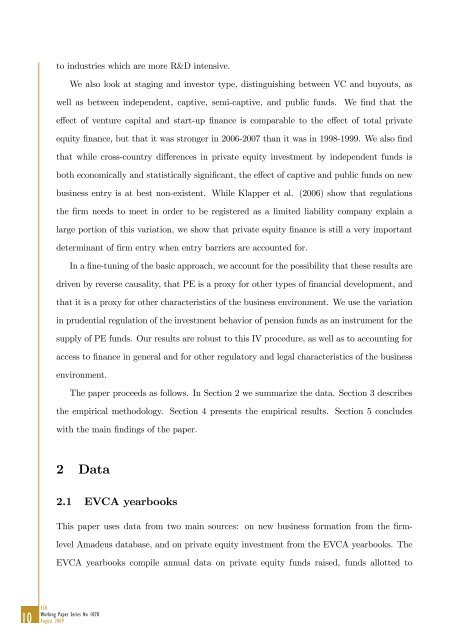On the real effects of private equity investment: evidence from new ...
On the real effects of private equity investment: evidence from new ...
On the real effects of private equity investment: evidence from new ...
- No tags were found...
Create successful ePaper yourself
Turn your PDF publications into a flip-book with our unique Google optimized e-Paper software.
to industries which are more R&D intensive.We also look at staging and investor type, distinguishing between VC and buyouts, aswell as between independent, captive, semi-captive, and public funds.We …nd that <strong>the</strong>e¤ect <strong>of</strong> venture capital and start-up …nance is comparable to <strong>the</strong> e¤ect <strong>of</strong> total <strong>private</strong><strong>equity</strong> …nance, but that it was stronger in 2006-2007 than it was in 1998-1999. We also …ndthat while cross-country di¤erences in <strong>private</strong> <strong>equity</strong> <strong>investment</strong> by independent funds isboth economically and statistically signi…cant, <strong>the</strong> e¤ect <strong>of</strong> captive and public funds on <strong>new</strong>business entry is at best non-existent. While Klapper et al. (2006) show that regulations<strong>the</strong> …rm needs to meet in order to be registered as a limited liability company explain alarge portion <strong>of</strong> this variation, we show that <strong>private</strong> <strong>equity</strong> …nance is still a very importantdeterminant <strong>of</strong> …rm entry when entry barriers are accounted for.In a …ne-tuning <strong>of</strong> <strong>the</strong> basic approach, we account for <strong>the</strong> possibility that <strong>the</strong>se results aredriven by reverse causality, that PE is a proxy for o<strong>the</strong>r types <strong>of</strong> …nancial development, andthat it is a proxy for o<strong>the</strong>r characteristics <strong>of</strong> <strong>the</strong> business environment. We use <strong>the</strong> variationin prudential regulation <strong>of</strong> <strong>the</strong> <strong>investment</strong> behavior <strong>of</strong> pension funds as an instrument for <strong>the</strong>supply <strong>of</strong> PE funds. Our results are robust to this IV procedure, as well as to accounting foraccess to …nance in general and for o<strong>the</strong>r regulatory and legal characteristics <strong>of</strong> <strong>the</strong> businessenvironment.The paper proceeds as follows. In Section 2 we summarize <strong>the</strong> data. Section 3 describes<strong>the</strong> empirical methodology. Section 4 presents <strong>the</strong> empirical results. Section 5 concludeswith <strong>the</strong> main …ndings <strong>of</strong> <strong>the</strong> paper.2 Data2.1 EVCA yearbooksThis paper uses data <strong>from</strong> two main sources: on <strong>new</strong> business formation <strong>from</strong> <strong>the</strong> …rmlevelAmadeus database, and on <strong>private</strong> <strong>equity</strong> <strong>investment</strong> <strong>from</strong> <strong>the</strong> EVCA yearbooks. TheEVCA yearbooks compile annual data on <strong>private</strong> <strong>equity</strong> funds raised, funds allotted to10 ECBWorking Paper Series No 1078August 2009















